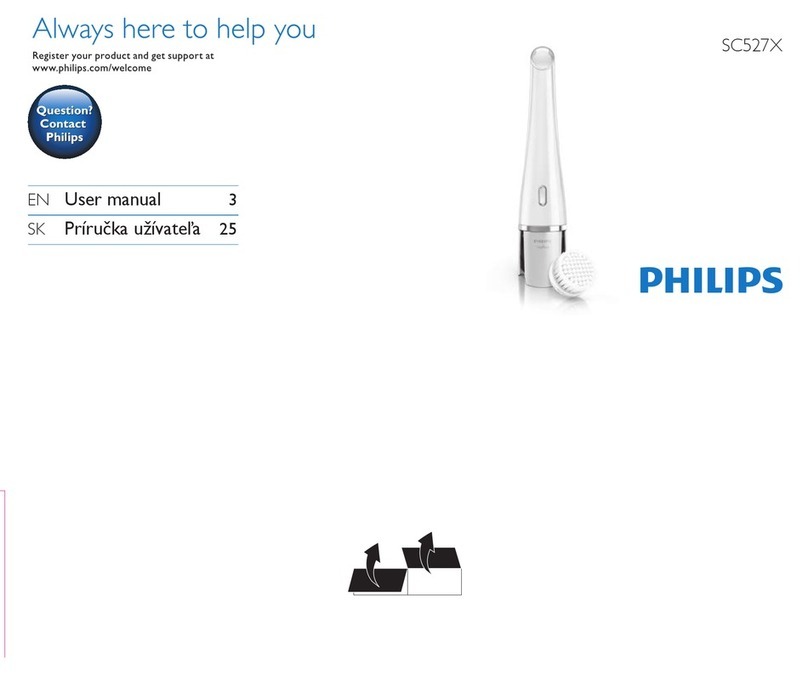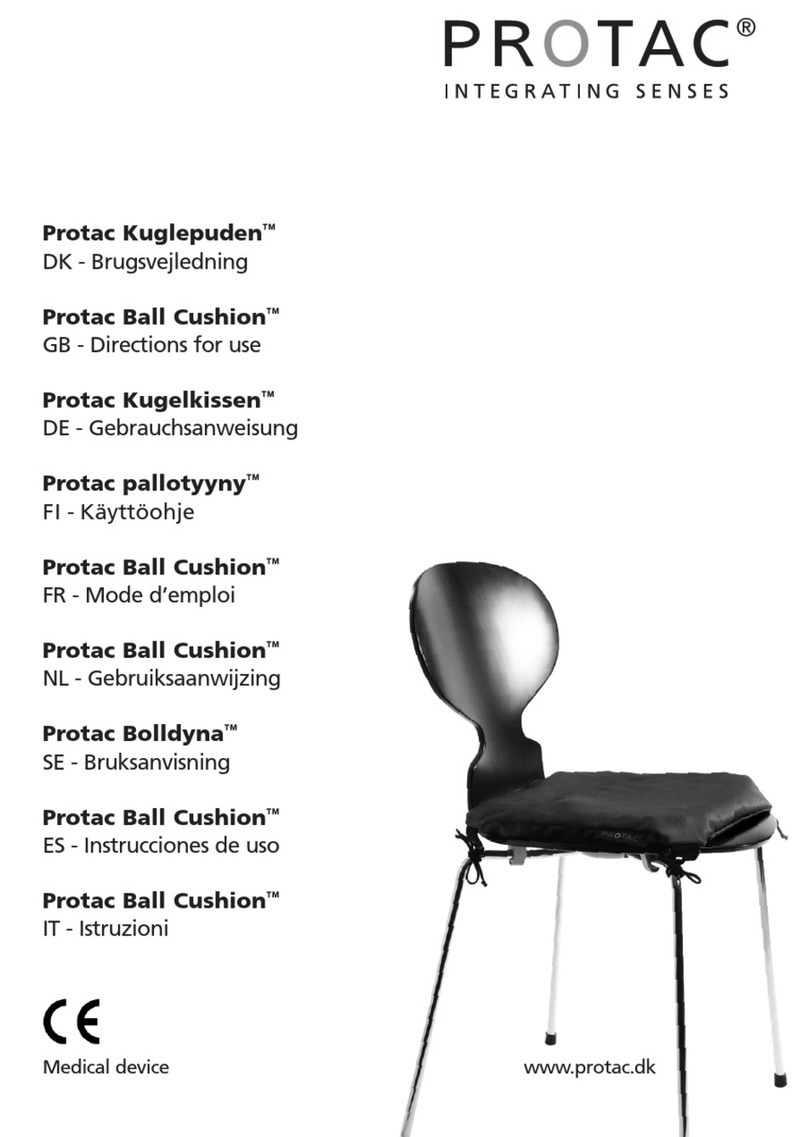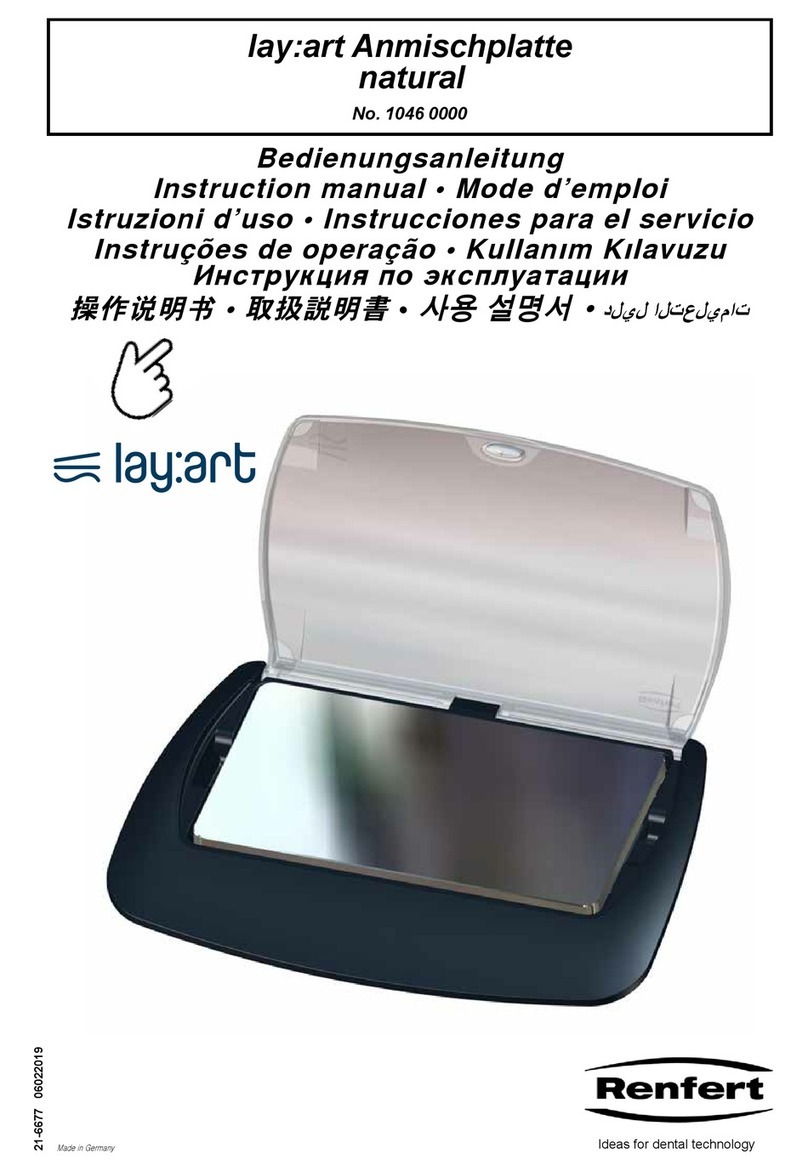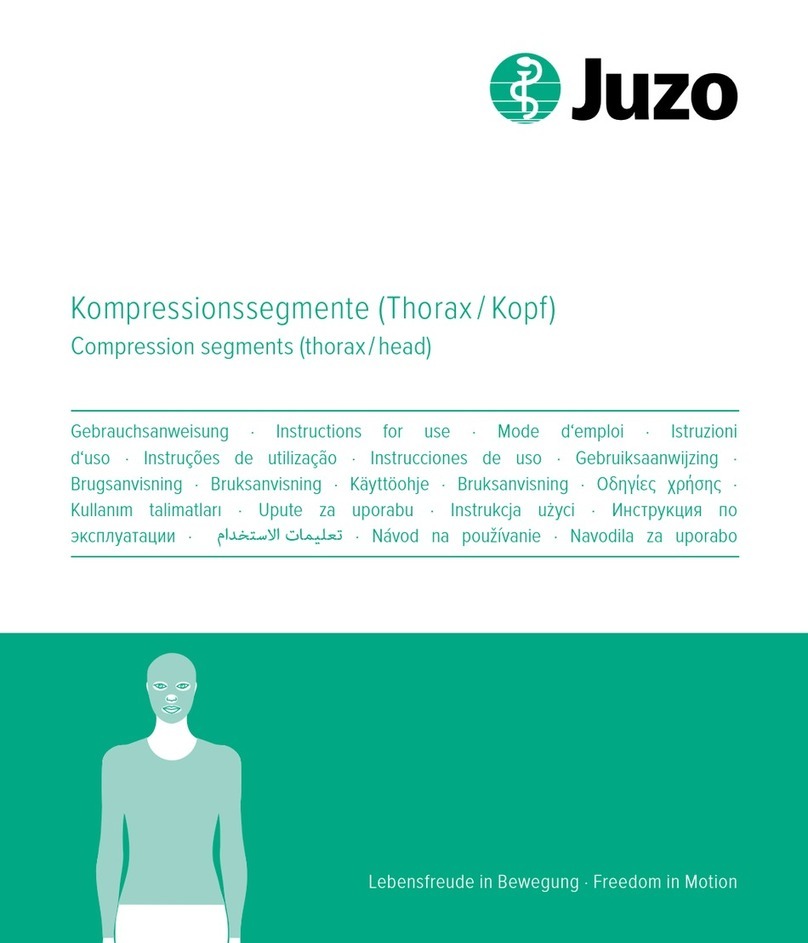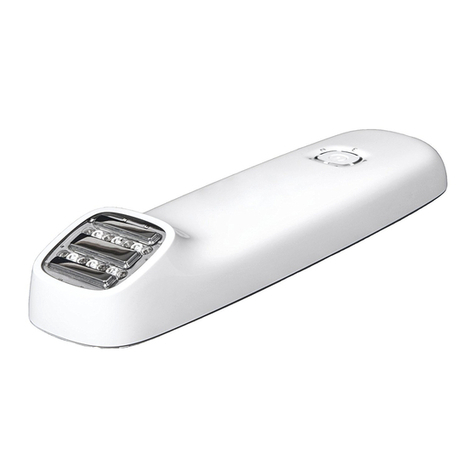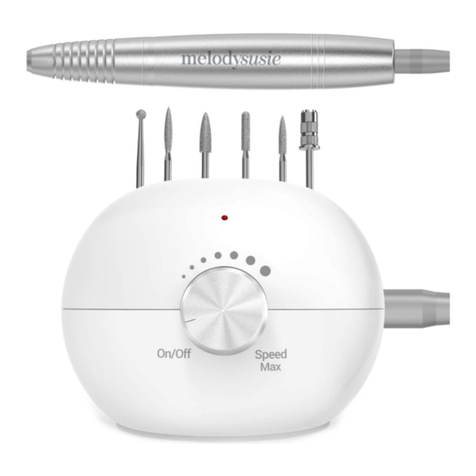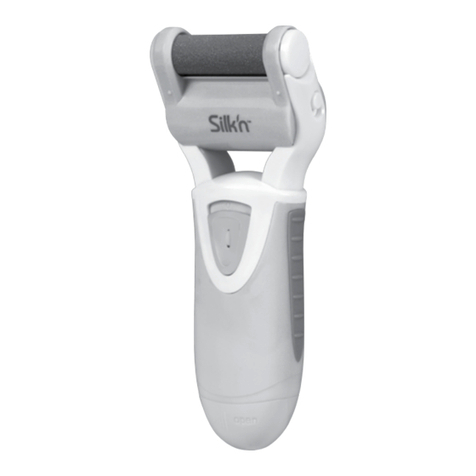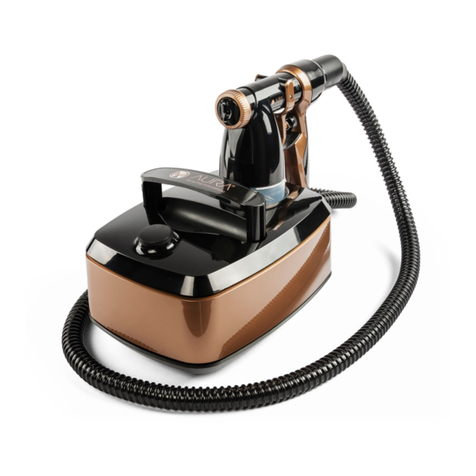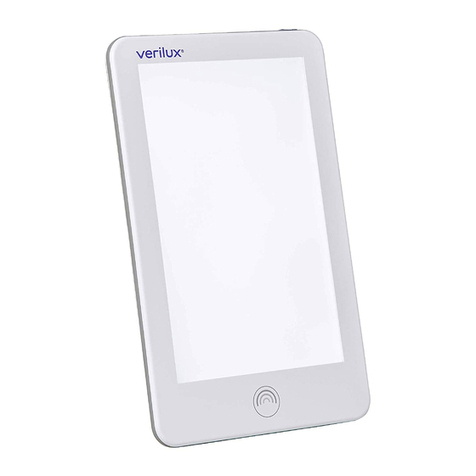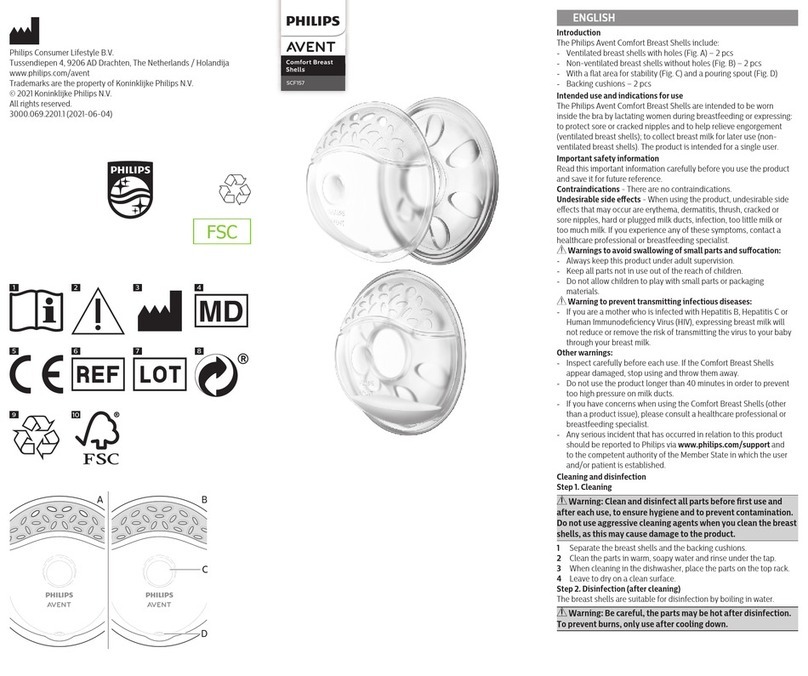NeuroMove NM900 Instruction Manual

NeuroMove®
PATHWAY
TO
RECOVERY
Neur
oM
o
v
e
®
NM900
PROGRAMMING GUIDELINES

2

3
Table of Contents
S
af
et
y
I
nf
or
ma
tion
.................................................................................... 4
P
rogramming
the
Neur
oM
o
v
e®
.............................................................. 15
Adjust
T
hr
eshold
..................................................................................... 11
Rest Period
.............................................................................................. 12
Operational
M
odes
................................................................................. 13
Change
P
ar
amet
ers
................................................................................. 14
F
r
equency
............................................................................................... 14
Pulse
W
idth
............................................................................................. 15
S
timula
tion
P
er
iod .................................................................................. 15
Ramp
-
On
T
ime
........................................................................................ 16
R
amp
-
O
ff
T
ime
........................................................................................ 16
S
ensitivit
y
R
ange
.................................................................................... 17
T
r
ea
tmen
t
T
imer
...................................................................................... 18
Set
Defaults............................................................................................ 18
Ba
tt
ery
Charge
S
ta
tus
............................................................................. 19
Audio
Enable.......................................................................................... 19
Compliance
Data.................................................................................... 20
Operational Mode
Descriptions ............................................................ 21
S
tr
oke
R
ehabilita
tion
Mode
...................................................... 21
SCI
Mode.................................................................................. 23
Manual
Mode
............................................................................ 24
S
timulation-
Only
mode
............................................................ 24
Audio
P
rompts
........................................................................................ 24
Warranty ................................................................................................ 25

4
S
af
et
y
I
nf
or
ma
tion
Equipmen
t
Classification
As
per the International Electrotechnical Commission standard
IEC
60601-1,
and the
E
urop
ean
standard
EN
60601-1, Medical Electrical
E
quipment,
G
ener
al
Requirements for
S
afet
y
,
the NeuroMove® is classified as
follows:
Type BF
E
quipmen
t
A Type BF piece
of equipment
is one
that
provides a particular
degree
of protection
against electric shock
,
particularly regarding
allowable
leakage
cur
r
en
t
.
A
Type BF
applied
part
is one
that
is
floating above
ground
and is
isola
t
ed
from
all
other
parts
of the
equipmen
t
.
Internally Powered Equipment
The
Neur
oM
o
v
e®
is classified as
an internally powered devic
e
.
Note:
Use
only with
supplied battery
char
ger
:
Input range:
100-240 VAC, 50-60 Hz.
Output:
12 VDC, 500 m
A.
Electromagnetic Compatibility
Conforms
to
IEC
60601-1-2.
Temperature
Operating temperature
range:
0°
-
50° C (32°
-
122° F)
S
t
or
age
temperature
range:
-20°
-
70° C (-4°
-
158° F)
Humidity
Operating relative humidity
range:
0-95%, non-condensing
Transport and s
t
or
age
relative humidity
range:
0-95%, non-condensing
Pressure
Operating pressure
range:
500-1060 hPa
Transport and s
t
or
age
pressure
range:
500-1060 hPa
Water
I
ngr
ess
Ordinary
equipmen
t
.
This device
has
protection against
ingress
of w
a
t
er
.
Flammable
Anesthetics
This device is
not
suitable
for
use
in the
presence
of
a
flammable
anesthetic mixture
with
air,
or in the
presence
of
a
flammable
anesthetic mixture
with
oxygen
or
nitrous
o
xide
.
Disinfection
The enclosure and
patient
cable may
be
disinfected and
cleaned
with
a 70% isopropyl alcohol
solution.

5
S
ymbols
S
ymb
ols
marked on the device are defined
b
elo
w
.
Type BF
Equipment
This symbol
indica
t
es
that the patient applied
parts (electrodes) are Type
BF
(floating
from
ground)
offering the
user a specific level
of
saf
et
y
.
Attention, consult accompanying documents
The
operator
must
r
ead
,
understand
,
and
follow
all instructions
in the accompanying
documents
including
all
w
ar
nings
,
cautions
,
and precautions
before
using
the
medical devic
e
.
Standby/On
This symbol
indica
t
es
that the
labeled
switch
electronically cycles
the
DC power
on
and
off for part of the
equipment.
Note: to
disc
onnec
t
the
e
x
t
er
nal
charger
input
,
unplug the power
cord
of the
supplied
AC adapter
from the
AC mains
r
ec
eptacle
.
Waste Electrical and Electronic Equipment (WEEE)
This
product
may contain substances
known to be
hazardous
to the environment
or to
human
health. It
should
be
disposed
of
properly (for
e
xample
,
at
your local waste collection administration
or
recycling plant)
and
in
accordance
with
local
or
dinanc
es
.
Refer
to
Instruction Manual/Programming Guidelines
The
operator must
r
ead
,
understand
,
and
follow
all instructions
in the
accompanying
document including
all
w
ar
nings
,
cautions
,
and
precautions before
using
this medical devic
e
.

6
Warnings
The device does
not function
as a medical device when
e
x
t
er
nal
battery
charger is
plugged in
and battery
is being
r
echar
ged
.
The device does
not
incorporate
a power switch
to
isola
t
e
the system from the
AC
mains
.
Unplug
the
power cord
of the
AC
battery
charger from the
AC mains
outlet in
order
to
positively
disc
onnec
t
from the
A
C
mains
.
The device is capable
of
generating current
densities for electrodes
exceeding
2
mA rms/cm
2
which may require
special attention of the operator.
Do
not
exceed
2
watts/cm
2
with
recommended
elec
tr
odes
,
assuming
a
load
of
1000 Ω
.
·
1”
round:
Maximum stimulation setting
=
28 mA
·
2”
round:
Maximum stimulation setting
=
100
mA
·
2”
square: Maximum stimulation setting
=
100
mA
Output
waveform/power
information
When delivering stimulation
energy, the Neur
oMo
v
e
®
is a constant
current
output
device. Therefore its output
v
oltage
,
current, and power is
dependent
upon the load as
well as the pulse width and frequency of the
output
waveform. The
maximum peak
voltage
that
the
Neur
oMo
v
e
®
can
pro
duc
e
is 100 V (1 KΩ load). The
maximum peak
current
that
the
Neur
oMo
v
e
®
can
produce is 100 mA (1 KΩ load). The
maximum output
power
that the
Neur
oMo
v
e
®
can produce is 1.28 W (1 KΩ
load).
·
Maximum peak output voltage (1 KΩ load) = 100 V
· Maximum peak output current (1 KΩ load) = 100 mA
· Maximum peak output voltage (500 Ω load) = 50 V
· Maximum peak output current (500 Ω load) = 100 mA
· Maximum peak output voltage (2 KΩ load) = 100 V
· Maximum peak output current (2 KΩ load) = 50 mA
· Pulse width range: 50 - 400 µs
· Pulse frequency range: 2 - 160 Hz
· Maximum RMS voltage (1 KΩ load) = 35.78 V
· Maximum RMS current (1 KΩ load) = 35.78 mA
· Maximum output power (1 KΩ load) = 1.28 W
· Maximum RMS voltage (500 Ω load) = 17.89 V
· Maximum RMS current (500 Ω load) = 35.78 mA
· Maximum output power (500 Ω load) = 0.64 W
· Maximum RMS voltage (2 KΩ load) = 35.78 V
· Maximum RMS current (2 KΩ load) = 17.89 mA
· Maximum output power (2 KΩ load) = 0.64 W
The device is capable of generating currents and voltages in excess of 10 mA
RMS and 10 V RMS, respectively, into a 1000 Ω load as shown above. A

7
yellow LED indicator is provided on the front panel to show that the unit is
delivering energy for any non-zero value of stimulation output (1-100 mA).
Patients with an implanted electronic device (for example a cardiac
pacemaker) should not be subjected to stimulation unless specialist medical
opinion has first been obtained
.
Stimulation should not be applied transthoracically in that the introduction of
electrical current into the heart may cause cardiac arrhythmias.
Simultaneous connection of a patient to high frequency surgical equipment may
result in burns at the site of the stimulator electrodes and possible damage to the
stimulator.
Operations within close proximity (within 1 m) of shortwave or microwave therapy
equipment may produce instability in the stimulation output.
The safety of this device for use during pregnancy or birth has not been
established.
This device should only be used under the continued supervision of a trained
physician.
This device does not have a curative value.
The user must keep this device out of the reach of children.
Electronic monitoring equipment (such as ECG monitors and ECG alarms) may not
operate properly when this device is in use.
The long-term effects of chronic electrical stimulation are unknown.
Stimulation should not be applied over swollen, infected or inflamed areas of skin,
eruptions, e.g. phlebitis, thrombophlebitis, varicose veins, etc.
Stimulation should not be applied over, or in proximity to, cancerous lesions.
Simultaneous connection of a patient to high frequency surgical equipment may
result in burns at the stimulator electrodes and possible damage to the stimulator.
Operations within close proximity (with one meter) of shortwave or microwave
therapy equipment may produce instability in the stimulation output.
STRANGULATION HAZARD. The lead wire included with this product presents a
potential strangulation hazard. Keep this cord out of the reach of children.

8
Indications
for
U
se
•
Maintaining or increasing range of motion for stroke rehabilitation
by muscle re-education.
•
Relaxation of muscle spasms, prevention or retardation of disuse
atrophy, increasing local blood circulation.
•
Biofeedback and relaxation.
C
on
tr
aindica
tions
Receptive or global aphasia to the degree that the patient can not
understand the process involved in using the NeuroMove®.
Powered muscle stimulators should not be used on patients with
cardiac demand pacemakers.
Powered muscle stimulators should only be used under medical
supervision for adjunctive therapy for the treatment of medical diseases
and conditions.
Powered muscle stimulators should not be used on carotid sinus (neck)
region or transcerebrally (through the head).
Powered muscle stimulators should not be used whenever pain syndromes
are undiagnosed until etiology is established.
Precau
tions
Isolated cases of skin irritation may occur at the site of the electrode placement
following long-term application.
Effectiveness is highly dependent upon patient selection by a person qualified in
management of pain patients.
Safety of powered muscle stimulators for use during pregnancy has not been
established.
Caution should be used for patients with suspected or diagnosed heart problems.

9
Caution should be used for patients with suspected or diagnosed epilepsy.
Caution should be used in the presence of the following:
1. When there is a tendency to hemorrhage following acute trauma or fracture.
2. Following recent surgical procedures when muscle contraction may disrupt the
healing process.
3. Over the menstruating or pregnant uterus
4. Over the areas of the skin which lack normal sensation.
Some patients may experience skin irritation or hypersensitivity due to the electrical
stimulation or electrically conductive medium. The irritation can usually be reduced by
using an alternate conductive medium, or alternate electrode placement.
Electrode placement and stimulation settings should be based on the guidance of the
prescribing physician.
This device should be kept out of reach of children.
This device should be used only with the leads and electrodes recommended for use
by the manufacturer.
This device should not be used while driving, operating machinery, or during any
activity in which involuntary muscle contractions may put the user at undue risk of
injury.

10
Adverse Reactions
Skin
irritation
and burns beneath
the
electrodes have been
reported
with the
use
of
powered muscle
stimula
t
ors
.
M
ain
t
enanc
e
and
C
alibr
a
tion
Do
not
remove
the
c
o
v
er
.
There are
no
user serviceable
par
ts
.
Refer all ser
vic
e
to
authorized Zynex Medical
personnel
.
No preventative inspections are
r
equired
.
Factory testing ensures equipment
accuracy and response.

11
P
r
og
ramming
the
Neur
oM
o
v
e
®
S
ettings
normally
do not
need
to be
adjusted
.
See
below on how to change
from the
default
S
tr
oke
R
ehab
mode
to the
more sensitive Spinal Cord
Injury
(SCI)
mode
.
The
unit
is programmed
by
stepping
through the
various
programming
functions
.
Each
programming
function
is described
in
sequence
belo
w
.
T
o
program a particular function, press
the
Program
button in
sequence
un
til
the
desired
function
is
display
ed
.
Pressing
the
Program
button in consecutive
fashion
will
skip over any programming functions
that
are
not
desir
ed
.
To
exit
the
programming
mode
,
consecutively press
the
Program
button until the
programming mode is
e
xit
ed
.
Note: The
unit
will
automatically exit
the
programming mode
after 20
seconds
if a
key press is
not detected.
Adjust T
hr
eshold
To change
the
thr
eshold
,
press
the
program
button
onc
e
.
The threshold is
the
signal level
at
which stimulation is
tr
igger
ed
.
If the
patient
is able
to
produce enough signal strength
to
meet
or
exceed
this
thr
eshold
,
an electrical muscle stimulation signal
will be fed to the electrodes
in
order
to
produce a
contraction.
The threshold is shown
by
a horizontal
line on the
display
.
In
S
tr
oke
R
ehab
and
SCI
modes
the
threshold is automatically adjusted upward
or downward
every 15 seconds
in
order
to
track
the
pa
tien
t
’
s
pr
ogr
ess
.
In Manual mode
the
threshold remains
at
a fixed
lev
el
.
See
Operational Modes setting
belo
w
.
To increase
the
thr
eshold
,
press
the
Up
button.
The threshold
will
increase as
shown
belo
w
.
Adjust Threshold
↑↓

12
To decrease
the
thr
eshold
,
press
the
Down
button.
The threshold
will
decrease as shown
belo
w
.
Adjust Threshold
↑↓
When
in
S
tr
oke
R
ehab
or
SCI
mode
,
the
threshold
will
adjust
automatically
during the
next sampling period
(15 seconds). In Manual mode
the threshold
will
remain as set. See
Operational Mode settings
belo
w
.
Rest Period
To change
the
rest
per
iod
,
press
the
program
button
once
again.
The rest period is
the time
after stimulation
ends
during
which
the patient is
encouraged
to
relax as much as
possible
.
The rest period can
be
adjusted
in
the
range
from
0.1
-
60
sec
onds
.
The default is 15
sec
onds
.
Note: the word
“R
elax
”
flashes
in the
upper
right
corner
of the
display
during the
rest
per
iod
.
Rest
Period:
15
sec.
To increase
the
rest
per
iod
,
press
the
Up
button.
To decrease, press
the Down
butt
on.

13
Operational
M
odes
To change
the
operational mode
,
press
the
program
button
once
again.
The
Neur
oM
o
v
e®
has
four different
operational
modes
.
Stroke
Rehabilitation
This is
the
normal mode
for the
Neur
oM
o
v
e®.
It
has
good low-level
sensitivity and a
wide
dynamic
r
ange
.
The range is 1.25-1000
micro-
volts (58 decibels).
It
is
intended
primarily
for
stroke
rehabilitation.
SCI (Spinal Cord
Injury)
This mode is similar
to
S
tr
oke
R
ehabilita
tion
but
has more
low-level
sensitivity and
less
r
ange
.
It
is
intended
primarily
for spinal
cord injury
rehabilitation.
There are
two
sensitivity ranges available:
0.25-
25
microvolts (40 decibels) and 0.50-50 microvolts (40 decibels).
S
ee
Change Parameters
programming
below for
range
selection
pr
oc
edur
e
.
Manual
This mode is similar
to
S
tr
oke
R
ehabilita
tion,
but
requires manual
setting of the
thr
eshold
.
Stim
Only
In this mode
,
the unit
acts like a
stimulator
only
.
S
ee
“Operational
Modes Descriptions”
belo
w
.
Mode:
Stroke
Rehab
Use Up and Down
buttons to
selec
t
the
desired
mode
.

14
Change
P
ar
amet
ers
To change
paramet
ers
,
press
the
program
button
once again. Then press
the
Down
butt
on.
Change
Parameters?
↓
F
r
equenc
y
The frequency is
the
r
a
t
e
at
which stimulation pulses are
sen
t
.
For e
xample
,
for
a 50 Hz
fr
equenc
y
,
pulses are sen
t
at
a
r
a
t
e
of
50 per second
or
one
every
0.020
sec
onds
.
The frequency can
be
selec
t
ed
in the
range
of 2 -
160 Hz.
T
he
default is 50
H
z.
Frequency:
50
Hz
To increase
the fr
equenc
y
,
press
the
Up
button.
To decrease, press
the Down
button.
This parameter normally does
not
need
to be
changed
by the
user
.

15
Pulse Width
To change
the
stimulation pulse
width,
press
the
program
button
once
again.
The pulse
width
can
be
selec
t
ed
in the
range
from
50
-
400 µs
(micr
osec
onds)
in 5
microsecond
incremen
ts
.
The default is 200
micr
osec
onds
.
T
his
parameter normally does
not
need
to be
changed
by the
user
.
Pulse
Width:
200
uS
To increase
the
pulse
width,
press
the
Up
button.
To decrease, press
the Down
butt
on.
Stimulation Period
To change
the
stimulation
per
iod
,
press
the
program
button
once
again.
The stimulation period is
the time during
which
unit
delivers electrical
energy
to the patient to
cr
ea
t
e
a muscle
contraction.
The stimulation
time
can
be
selec
t
ed
in the
range
from
0.5
-
30
sec
onds
.
The default is
5
sec
onds
.
Note: the
word
“
S
tim
”
along
with the
intensity appears
in the
upper
lef
t
corner
of the
display during
the
stimulation
period.
Stim.
Period:
5
sec.
To increase
the
stimulation
per
iod
,
press
the
Up
button.
To decrease, pr
ess
the
Down
butt
on.

16
Ramp
-
On
T
ime
To change
the
ramp
on time
,
press
the
program
button
once
again.
When stimulation is initially delivered
to the
pa
tien
t
,
the output
pulse level
in-
creases
from
zero
to full
intensity
during
a specified period
of time
.
This
effect
provides a more comfortable transition
for the patient
rather
than delivering
full output from the
beg
inning
.
For e
xample
,
if the
ramp
on time
is
one
sec
ond
,
it
takes one second
for the output
pulse level
to
increase
from zero
intensity
to full in
t
ensit
y
.
The ramp-on
time
is adjustable
in the
range
from
0.1
- 6
sec
onds
.
The default is one
sec
ond
.
This parameter normally does
not
need
to be
changed
by the
user
.
Ramp On
Time:
1
sec.
To increase
the
ramp
on time
,
press
the
Up
button.
To decrease, pr
ess
the
Down
button.
Ramp-Off Time
To change
the
ramp
off time
,
press
the
program
button
once
again.
Similar
to
ramp
on time
,
when
the
stimulation period is
o
v
er
,
the unit
gradu
ally turns
off the
intensity
from full
intensity
to
zero
during
a specified
period of time
.
For e
xample
,
if the
ramp
off time
is one
sec
ond
,
it
takes one
second for the output
pulse level
to
decrease
from full
intensity
to
zero
in
t
ensit
y
.
Again,
this effect provides
a more comfortable transition
for the
patient rather than abruptly
removing
the stimulation.
The ramp-off
time
is
adjustable
in the
range
from
0.1
- 6
sec
onds
.
The default is one
sec
ond
.
This
parameter
normally does
not
need
to be
changed
by the
user
.

17
Ramp Off
Time:
1
sec.
To increase
the
ramp
off time
,
press
the
Up
button.
To decrease, press
the
Down
button.
Sensitivity Range
To change
the
sensitivity
r
ange
,
press
the
program
button
once
again.
The sensitivity range describes
the
range
of
signal levels
from the patient
tha
t
the
Neur
oM
o
v
e®
can det
ec
t
.
When
in
S
tr
oke
R
ehab
operational mode there is
only
one
r
ange
,
1.25
– 1000
µV (microvolts).
S
wit
ch
to
SCI
operational mode
if
S
tr
oke
R
ehab
is
not
sensitive
enough (displayed signal levels are
at
a very
low
level
or bottomed out).
In SCI
mode
,
two
ranges are selectable: 0.25
-
25 µV and 0.50
-
50 µV. Use
the
latter if the
former is
too
sensitive (levels are reaching
maximum).
Sensitivity:
1.25-1000
uV
Press
the
Up
or
Down key
to
selec
t
the
desired
r
ange
.

18
Treatment Timer
To change
the
treatment time
,
press
the
program
button
once
again.
The
Neur
oM
o
v
e®
can
time
therapy sessions. The selectable
treatment
times
are
from
10
-
90
minut
es
,
in ten-minute
incremen
ts
.
The default
time
is
con
tinuous
.
The
unit will
automatically shut
off
after
the
selec
t
ed
amount of
time
.
In continuous mode
,
the unit
never turns
off
.
Treatment
Time:
Continuous
To increase
the
treatment time
,
press
the
Up
button.
To decrease, press
the
Down
butt
on.
Set
Defaults
To set
the
factory defaults
,
press
the
program
button
once
again.
If
any
of the
parameters are mistakenly set,
the
Neur
oM
o
v
e®
provides a way
t
o
return to
factory default
c
onditions
.
Set Defaults?
↓
To set defaults press
the
Down
button.
The display
will
sho
w
“DefaultsSet”
.
Press
the
programming
button
again
to exit the
Change Parameters
subfunction.

19
Battery Charge Status
The charge sta
t
e
of the built-in,
r
echargeable
,
7.4 V, 2000 mAH,
lithium-ion
battery
is provided
during
charging
or
dischar
ging
.
The
battery
is
charging
when
the
AC adapter is
plugged in.
The
battery
is discharging when
the
A
C
adapter is
not plugged in.
The value provided
indica
t
es
percentage
of full
char
ge
.
100% means
that the
battery
is
fully
char
ged
.
It
is recommended
t
o
charge
the
battery
at
least once every 2-3
w
eeks
.
Battery
Charge:
100%
Audio
Enable
To disable
or
enable audio pr
ompts
,
press
the
program
button
once
again.
The
Neur
oM
o
v
e®
provides audio prompts
to help
guide
the
user
in the opera-
tion of the
machine
.
See
the
“Audio
P
rompts
”
section
for
a detailed
explanation of
each audio pr
ompt
.
Audio prompts are
on by
default
.
Audio:
On
Press
the
Up
or
Down
button to turn
audio prompts
on or off
.

20
Compliance
Data
To view
the
compliance data, press
the
program
button
once
again.
The
unit
keeps track
of the
number
of
times and
amount of time
it
’
s
been
used
at
stimulation level g
r
ea
t
er
than 5
mA
(milliamps).
Compliance Data
↓
Press
the
Down
button to
view
the
compliance
data.
21 hrs., 30
min.
43
times
Press
the
P
rogramming
once again
to exit the
programming
mode
.
The
dis-
play
will
sho
w
“Restarting Ready
Mode
…
”.
Table of contents
Popular Personal Care Product manuals by other brands
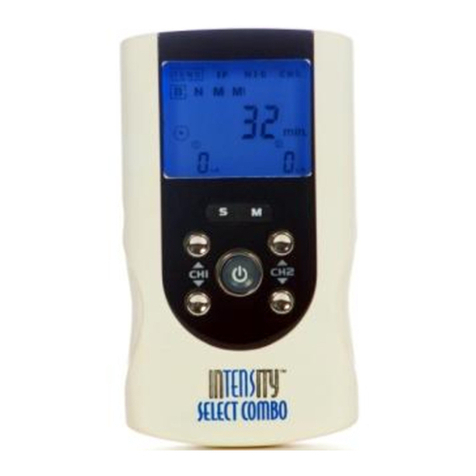
Current Solutions
Current Solutions InTENSity Select Combo instruction manual
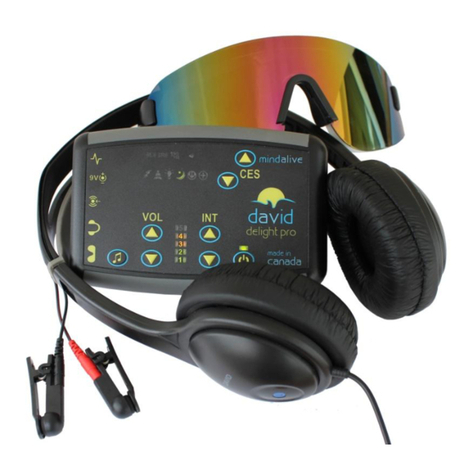
mind alive
mind alive david delight pro Operator's manual
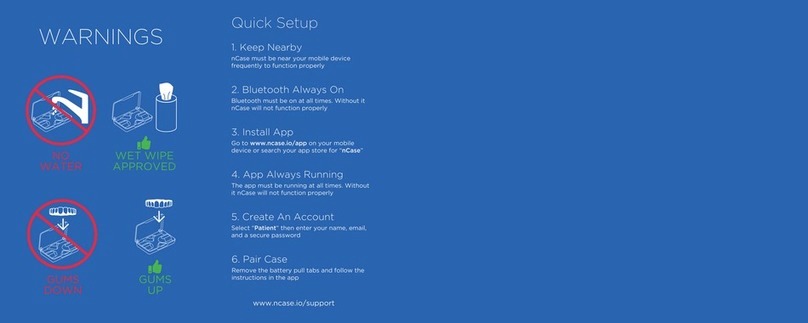
nCase
nCase SmartCase Quick setup
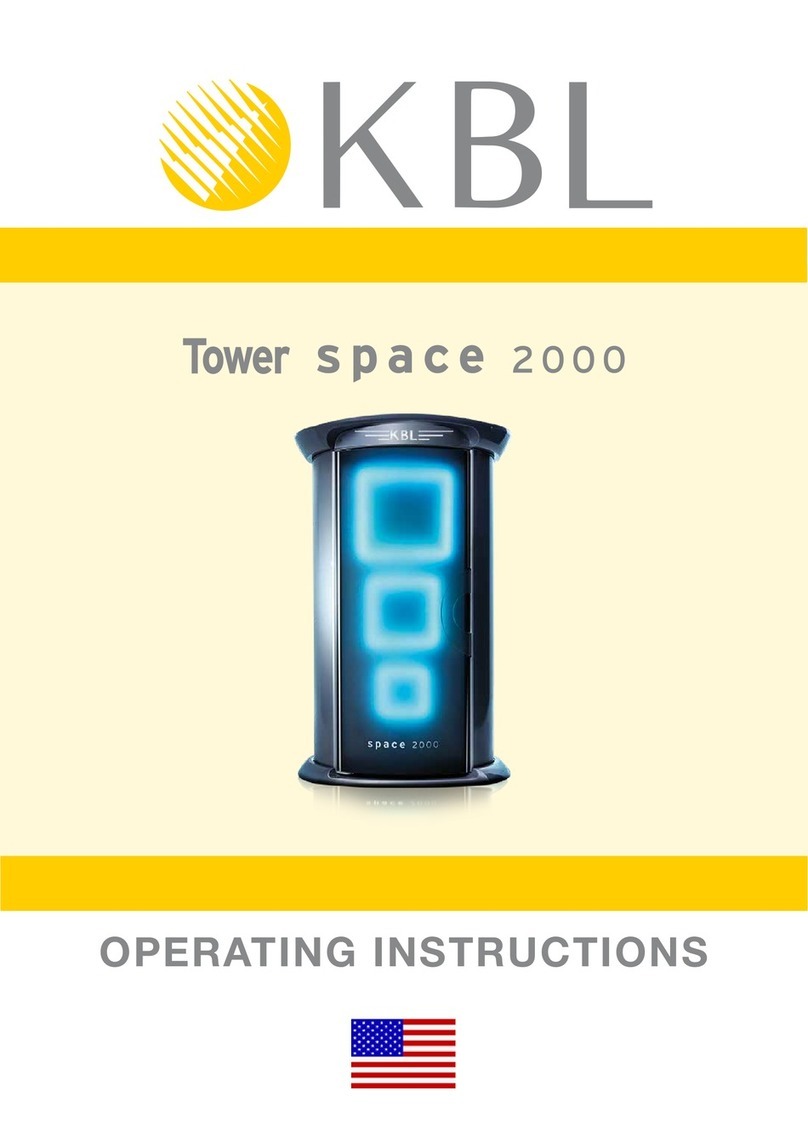
KBL
KBL Tower space 2000 operating instructions
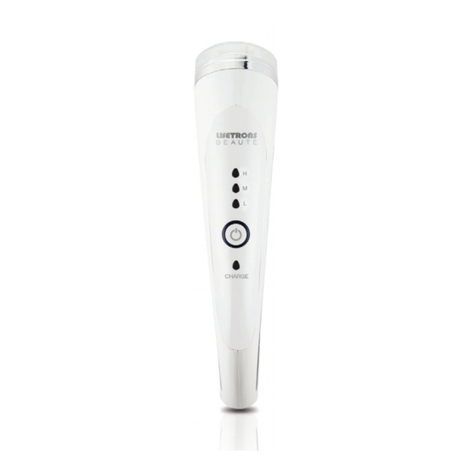
Lifetrons
Lifetrons PK-UMLLRF300-MT3 user guide
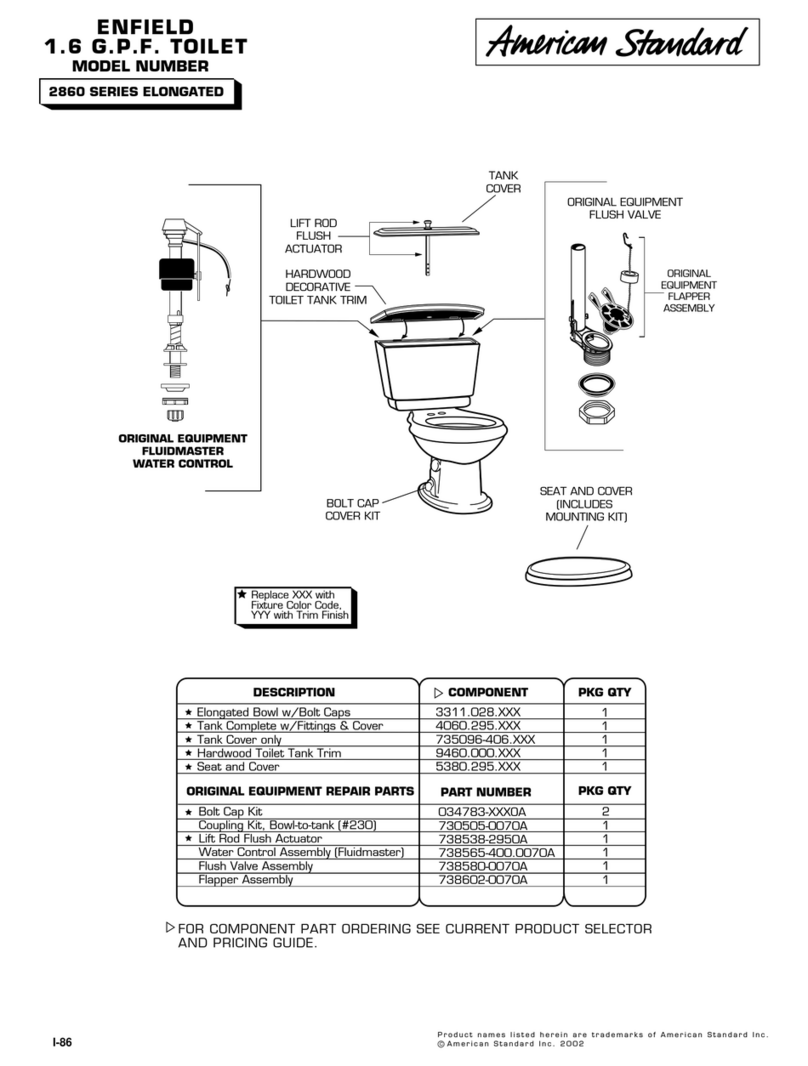
American Standard
American Standard Enfield 2860 Series parts list
